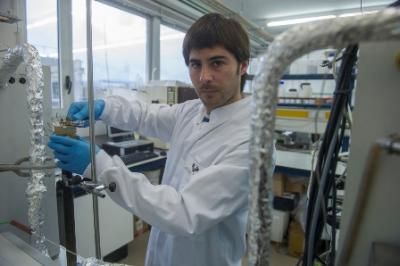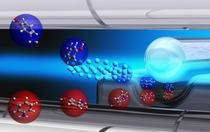Absorbing hydrogen fluoride gas to enhance crystal growth
Newly patented method could improve superconductors, optical devices and microelectronics
Two scientists at the U.S. Department of Energy's (DOE) Brookhaven National Laboratory have developed a method to control the buildup of hydrogen fluoride gas during the growth of precision crystals needed for applications such as superconductors, optical devices, and microelectronics. The invention — by Vyacheslav Solovyov and Harold Wiesmann and recently awarded U.S. Patent number 7,622,426 — could lead to more efficient production and improved performance of these materials.
Materials with highly ordered crystalline atomic structures have enormous potential for energy-saving devices such as superconductors, which carry current with no energy loss, and high-speed electronics. Such crystals are typically grown from precursors deposited on substrates — for example: tapes, wires, or wafers, such as those used in the production of computer chips.
Adding fluorine to the precursors enhances the transfer of crystalline order from the substrate to the growing material. But fluorine also presents a problem because it leads to the buildup of hydrogen fluoride gas. Hydrogen fluoride slows down the reaction that converts the precursor to the desired material, sometimes even stopping crystal growth in its tracks.
"You might think you could just vent the accumulating gas, but such methods have proven impractical," said Wiesmann. For one thing, you'd have to remove the gas uniformly, to avoid variations in pressure that might affect crystal growth, which becomes more difficult over larger areas. Also, other gases necessary to crystal growth, such as oxygen and water vapor, get extracted along with the hydrogen fluoride, and re-injecting these gases introduces more pressure problems.
"We've developed an improved method for removing hydrogen fluoride, based on absorption, that enhances the production of high-quality crystalline products." Wiesmann said.
The new method incorporates a solid material capable of absorbing hydrogen fluoride (HF) gas inside the reaction chamber. The solid material can be attached to the inner surface of the reaction chamber or free standing, as long as it is made to conform to the shape of the precursor at a uniform distance. This allows uniform extraction of HF across large areas, thereby yielding crystalline end products that are uniform and homogeneous regardless of the shape of the precursor material or the area it occupies inside the reaction chamber.
A wide range of materials from alkaline earth oxides to materials containing calcium, sodium, or even activated carbon can be used as HF absorbers. The HF absorber material could be sprayed, painted, or otherwise deposited onto an inert support such as quartz or various oxides to attach it to the reaction chamber. Or it could be made from a powder and pressed into a form that conforms to the shape of the growing crystals.
"Because these materials selectively absorb HF gas, water vapor, oxygen, and other gases that may be present and necessary for the conversion of the precursor material to finished crystals remain in the reaction vessel, undisturbed," Solovyov said.
Solovyov and Wiesmann demonstrated the effectiveness of this approach when growing crystals of a common yttrium-barium-copper-oxide (YBCO) superconductor. In these experiments, YBCO crystals grew at a faster rate in the presence of a barium-oxide HF absorber when compared to conventional methods of crystal growth. The method also preserves the uniformity of the crystal growth environment so that superconducting properties do not vary along the length of the film.
This specific reaction serves as only one example, and the patent applies to the many possible modifications and variations in the materials used and produced.
Most read news
Other news from the department science

Get the chemical industry in your inbox
By submitting this form you agree that LUMITOS AG will send you the newsletter(s) selected above by email. Your data will not be passed on to third parties. Your data will be stored and processed in accordance with our data protection regulations. LUMITOS may contact you by email for the purpose of advertising or market and opinion surveys. You can revoke your consent at any time without giving reasons to LUMITOS AG, Ernst-Augustin-Str. 2, 12489 Berlin, Germany or by e-mail at revoke@lumitos.com with effect for the future. In addition, each email contains a link to unsubscribe from the corresponding newsletter.



























































